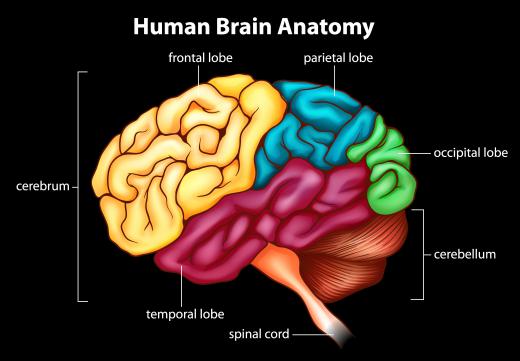What is the Frontal Cortex?
 Jessica Ellis
Jessica Ellis
The frontal cortex, also known as the frontal lobe, is a vital section of mammalian brains. In humans, the frontal cortex is at the front of the head, just behind the face. Frontal lobes are considered the hub of most higher functions and understanding, and many scientists believe that most behavioral traits, motor skills, and problem solving tactics are based in this area of the brain.
The anatomy and function of the frontal cortex is complex and not completely understood. The frontal lobe is a hotbed of neurons, which respond to both external and internal stimuli and form patterns and pathways when stimuli are repeated. It is believed that the very front portion of the cortex is responsible for personality, behavior, and problem solving, whereas the rear portion of the frontal lobe relates to motor functions.

According to some scientists, the frontal cortex of humans continues to mature for about 20 years after birth. Until this point, neural pathways remain somewhat unspecified in a person’s brain. Although science has not discovered an exact explanation of how the brain matures, some studies suggest that early childhood maturation may be controlled primarily by genetic factors, while brain maturation in later childhood and around puberty may be due to environmental factors. What these studies seem to suggest is that life experiences in later development stages help form the patterns and pathways of the frontal cortex, creating the mainstays of individual personality.

In early treatment of mental disorders, it was not uncommon for doctors to perform frontal lobotomies on patients suffering from serious mental illness. In a lobotomy, some of the frontal lobe is removed, often with devastating effects. While lobotomies could often quell dangerous or harmful personality tendencies, the procedure could also obliterate memory, speech, motor function, problem solving abilities, as well as destroy the person's original personality entirely.

Because of the position of the frontal cortex, it is quite easy to injure through impact. Damage to the area can cause serious changes in personality, including increasing likelihood of risky behaviors due to an inability to process environmental conditions correctly. Studies have shown that frontal cortex injuries rarely have an adverse affect on Intelligence Quotient (IQ) scores, as complex problem solving skills are not necessarily used to score well on IQ tests.

One famous case of frontal lobe damage is that of Phineas Gage, a 19th century construction foreman who survived a serious accident in which a metal rod was driven through his frontal lobe. Gage lost vision in one eye, but otherwise had an apparently complete physical recovery from the accident. However, in further studies of the case, doctors discovered numerous complaints from friends and relatives of Gage that suggested he survived the accident only to recover with a completely unrecognizable personality. Gage is something of a legend in the world of neural function, as his widely studied case was one of the first clear situations linking personality to frontal cortex function.
AS FEATURED ON:
AS FEATURED ON:
















Discussion Comments
Phineas Gage was also some of the first proof scientists had that the parts of our brains which maintain survival- things like consciousness and body function- and the parts that maintain our emotions and thoughts are different. I imagine it must have been, at that time, something like the decoding of the human genome was for us.
I remember reading about Phineas Gage, first in a high school biology class and then later in a college psychology class. He is a very interesting example of the way that our personalities, which we tend to believe are entirely within our own control, might be formed by the way that our brains are wired.
Post your comments